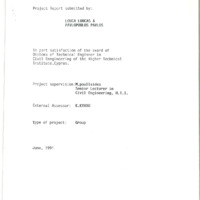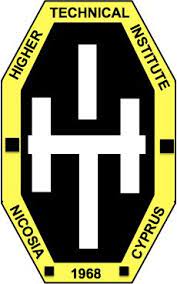An estimate of the engineering properties of solis
- Τίτλος
-
An estimate of the engineering properties of solis
- Θέμα
- Soil mechanics--Cyprus
- Soils--Testing
- Δημιουργός
-
Louca, Loucas
- Pavlopoulos, Pavlos
- Πηγή
- Higher Technical Institute
- Το πλήρες κείμενο είναι διαθέσιμο από το Υπουργείο Ενέργειας, Εμπορίου Βιομηχανίας και Τουρισμού
- Εκδότης
- Library of Cyprus University of Technology
- Ημερομηνία
- 1991
- Συνεισφέρων
- Poullaides, M.
- Δικαιώματα
- Απαγορεύεται η δημοσίευση ή αναπαραγωγή, ηλεκτρονική ή άλλη χωρίς τη γραπτή συγκατάθεση του δημιουργού και κάτοχου των πνευματικών δικαιωμάτων.
- Μορφή
- Γλώσσα
- eng
- Τύπος
- text
- Αναγνωριστικό
-
CED 0108
- Σύνοψη
-
One of the most important factor that a civil engineer will have to consider before commencing the design of any project are the engineering properties of any soil.
Soils are classified into different groups according to their particle size and their engineering properties. The object of soil classification is to provide a basic whereby engineers can group soils according to their physical characteristics and appearance for the purposes of comparing different soils, communicating their properties and to a limited extent assessing their suitability for engineering use.
In this particular project the engineering properties of both COARSE GRAINED (sands, gravels) and FINE GRAINED (clays) will be examined. In order to classify the soils, index tests, compaction test and shear strength tests were performed.
For coarse grained soils, sieve analysis, proctor test and direct shear test were carried out. The sieve analysis test was performed in order to obtain the grading curves of its particle sizes. The proctor test was carried out so as to determine the optimum moisture content at which maximum compaction is obtained The object of shear test was to estimate the angle of shear resistance.
For the fine grained soils, Atterberg limit tests (Liquid limit and plastic limit) and undrained triaxial test were carried out. For determing the liquid limit of soils the cone penetrometer method was used which is actually the first time used in Η.Τ.Ι Laboratories. By performing Atterberg limit tests (Liquid limit, plastic limit, Liquidity index and plasticity idex) were estimated in order to classify soils. The objectives of the undrained triaxial test was to determine the angle of shear resistance and also the undrained shear strength of the soil.
In order to have a representative picture of the different types of soils in Cyprus soil samples were taken from various places. Soil samples were taken from Paphos, Limassol, Larnaka and Nicosia.
Finally, hypothetical bearing capacity of foundations of each sample was calculated based on their engineering properties estimated before. Also possible engineering applications in civil engineering works were discussed.
- Πολυμέσα
-
 CED 0108.pdf
CED 0108.pdf
Τμήμα του An estimate of the engineering properties of solis


